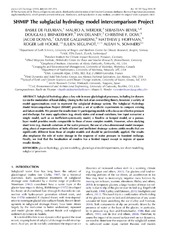| dc.contributor.author | de Fleurian, Basile | |
| dc.contributor.author | Werder, Mauro A. | |
| dc.contributor.author | Beyer, Sebastian | |
| dc.contributor.author | Brinkerhoff, Douglas J. | |
| dc.contributor.author | Delaney, Ian | |
| dc.contributor.author | Dow, Christine F. | |
| dc.contributor.author | Downs, Jacob | |
| dc.contributor.author | Gagliardini, Olivier | |
| dc.contributor.author | Hoffman, Matthew J. | |
| dc.contributor.author | Hooke, R. LeB. | |
| dc.contributor.author | Seguinot, J. | |
| dc.contributor.author | Sommers, Aleah | |
| dc.date.accessioned | 2020-06-17T16:38:26Z | |
| dc.date.available | 2020-06-17T16:38:26Z | |
| dc.date.issued | 2018-10-24 | |
| dc.Published | de Fleurian B, Werder MA, Beyer S, Brinkerhoff DJ, et al. SHMIP The subglacial hydrology model intercomparison Project. Journal of Glaciology. 2018;64(248):897–916 | eng |
| dc.identifier.issn | 0022-1430 | en_US |
| dc.identifier.issn | 1727-5652 | en_US |
| dc.identifier.uri | https://hdl.handle.net/1956/22692 | |
| dc.description.abstract | Subglacial hydrology plays a key role in many glaciological processes, including ice dynamics via the modulation of basal sliding. Owing to the lack of an overarching theory, however, a variety of model approximations exist to represent the subglacial drainage system. The Subglacial Hydrology Model Intercomparison Project (SHMIP) provides a set of synthetic experiments to compare existing and future models. We present the results from 13 participating models with a focus on effective pressure and discharge. For many applications (e.g. steady states and annual variations, low input scenarios) a simple model, such as an inefficient-system-only model, a flowline or lumped model, or a porous-layer model provides results comparable to those of more complex models. However, when studying short term (e.g. diurnal) variations of the water pressure, the use of a two-dimensional model incorporating physical representations of both efficient and inefficient drainage systems yields results that are significantly different from those of simpler models and should be preferentially applied. The results also emphasise the role of water storage in the response of water pressure to transient recharge. Finally, we find that the localisation of moulins has a limited impact except in regions of sparse moulin density. | en_US |
| dc.language.iso | eng | eng |
| dc.publisher | Cambridge University Press | en_US |
| dc.rights | Attribution CC BY | eng |
| dc.rights.uri | http://creativecommons.org/licenses/by/4.0/ | eng |
| dc.subject | glacier hydrology | eng |
| dc.subject | glacier modelling | eng |
| dc.subject | glaciological model experiments | eng |
| dc.subject | ice-sheet modelling | eng |
| dc.subject | subglacial processes | eng |
| dc.title | SHMIP The subglacial hydrology model intercomparison Project | en_US |
| dc.type | Peer reviewed | |
| dc.type | Journal article | |
| dc.date.updated | 2019-12-05T11:25:21Z | |
| dc.description.version | publishedVersion | en_US |
| dc.rights.holder | Copyright 2018 The Author(s) | en_US |
| dc.identifier.doi | https://doi.org/10.1017/jog.2018.78 | |
| dc.identifier.cristin | 1623183 | |
| dc.source.journal | Journal of Glaciology | |
| dc.relation.project | EC/FP7: 610055 | |
| dc.relation.project | Notur/NorStore: NN4659K | |

